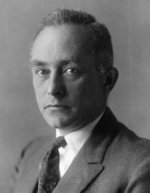|
 Max Born was born on December 11, 1882 in Breslau, which was at the time part of Prussian Silesia. His father, Gustav Born, was a professor of anatomy and embryology. His mother, Margarete Kauffmann came from a wealthy industrial family. Max Born was born on December 11, 1882 in Breslau, which was at the time part of Prussian Silesia. His father, Gustav Born, was a professor of anatomy and embryology. His mother, Margarete Kauffmann came from a wealthy industrial family.
Born went to the Konig Wilhelm Gymnasium in Breslau before attending the Universities of Bresalau, Heidelberg, and Zurich. Finally, he ended up at the University of Gottingen where he studied mainly mathematics, but also physics and astronomy. In 1906, he won the Prize of the Philosophical Faculty of the University for his research of elastic wire and tape stability. He graduated from Gottingen in 1907.
After graduating, Born studied at Cambridge for a short time with J. J. Thomson at the Cavendish Laboratory. The then went back to Breslau from 1908 to 1909 and studied under physicists Pringsheim and Lummer. He wrote a paper at this time that attracted the attention of Professor Minkowski at Gotttingen. Born was invited to collaborate with him, but Minkowski died shortly after. Born spent time going through his papers and publishing what he could.
Born lectured for a short time at Gottingen and then moved to Chicago to work with Albert Michelson. He lectured there on relativity and studied the Michelson grating spectrograph. In 1915, he moved to Berlin to work with Max Planck and had to join the German Armed Forces. He worked on sound ranging for the military. He was able to find time to study crystal lattices and published his first book on the topic.
After a brief position at the University of Frankfurt-am-Main after the war, Born became a professor at Gottingen. He stayed there for the following twelve years. During this time he refined his study of crystal lattice structures and studied quantum mechanics. He worked with Werner Heisenberg on using matrices to describe quantum mechanics. He also developed what is now called the Born interpretation of a wavefunction. This describes the mathematical probability of electrons in atoms.
In 1933, Born had to emigrate and returned to Cambridge to teach for three years. In 1935, he spend several months working at the Indian Institute of Science in Bangalore. He collaborated there with C.V. Raman. In 1936, Born became the Tait Professor of Natural Philosophy at the University of Edinburgh and remained there until retiring in 1953.
Born received many awards and honors for his work. Most importantly, he received the Nobel Prize for Physics in 1954 for his work with quantum mechanics. Born married Hedwig Eherenberg in 1913 and the two had three children. Born died in Gottingen on January 5, 1970 and is buried there.
Image: Max Born.
|